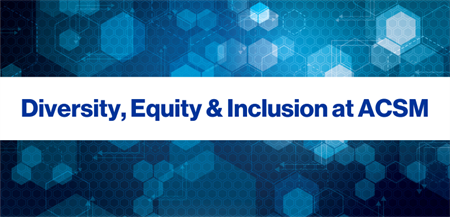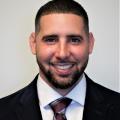Eduardo Esteban Bustamante, Ph.D., FACSM |
Jan.
19, 2021
 I was an undergraduate student at the University of Massachusetts, Amherst when I attended my first ACSM meeting. The year was 2005. I was a research assistant in the Physical Activity and Health Lab of Patty Freedson, Ph.D., FACSM, and the Muscle Biology and Imaging Lab of Priscilla Clarkson, Ph.D., FACSM. During my senior year, my lab mates and I volunteered to represent UMass at the New England ACSM Annual Student Bowl (this is a jeopardy-style competition). We got crushed! It was my fault. I got more than my fair share of questions wrong. On the bus ride home, I apologized to my teammates for making so many errors, but nobody was mad. We were all elated. The experience left us dreaming of possible futures at the intersections of sport, exercise and science.
I was an undergraduate student at the University of Massachusetts, Amherst when I attended my first ACSM meeting. The year was 2005. I was a research assistant in the Physical Activity and Health Lab of Patty Freedson, Ph.D., FACSM, and the Muscle Biology and Imaging Lab of Priscilla Clarkson, Ph.D., FACSM. During my senior year, my lab mates and I volunteered to represent UMass at the New England ACSM Annual Student Bowl (this is a jeopardy-style competition). We got crushed! It was my fault. I got more than my fair share of questions wrong. On the bus ride home, I apologized to my teammates for making so many errors, but nobody was mad. We were all elated. The experience left us dreaming of possible futures at the intersections of sport, exercise and science.
A few years later, I was studying for my Ph.D. in Kinesiology and Nutrition with David X. Marquez, Ph.D., FACSM, at the University of Illinois at Chicago. Dr. Marquez took me to my first ACSM National Meeting in 2008, where I saw him participate in the first cohort of the ACSM Leadership & Diversity Training Program (LDTP). The LDTP was established to mentor and retain members from backgrounds underrepresented in medicine and science (nationally, this includes some racial/ethnic minority groups, individuals with disabilities and individuals from disadvantaged backgrounds at all levels; and women at the doctoral level) to ACSM Fellowship over a five-to-10-year period. The LDTP was launched following the diversity-focused presidential platform of ACSM past-President W. Larry Kenney, Ph.D., FACSM. I wasn’t in the room for the 2003 ACSM presidential reception, but the legend goes that Dr. Kenney (a white man who raised three African American children) brought his children on stage during his address and told the crowd, “I want to tell my children that they too can one day be president of ACSM but looking at our history I can’t tell them that. I think it’s time for that to change.” He followed through by establishing the Task Force on Diversity Action.
I pause here to acknowledge the courage Dr. Kenney displayed in that moment. At a reception to honor his rare achievement—Dr. Kenney served as ACSM’s 46th president—he deflected the attention away from himself (sacrificing hard-earned adulation) to do something uncomfortable for everyone in attendance. He recognized publicly that the opportunity he had to compete for the honor of leading the college had not been made available to everyone. At the time of Dr. Kenney’s address, this was indisputable, all 45 of his predecessors had been white and all but four were men. What Dr. Kenney delivered that day was not just a call for racial integration at ACSM, it was also a call for meritocracy; a call for structural and cultural barriers that exclude some groups to be stripped away; a call for our most talented to be extended the opportunity to compete, regardless of their background. In my view, we should embrace large variability in achievement between individuals based on talent and enterprise, but we should be deeply troubled where variability in achievement neatly follows sociodemographic lines.
The way ACSM responded to Dr. Kenney is nothing short of inspirational. We did not run from it. We did not sweep it under the rug. We did not make excuses. We faced it and got busy working. Isn’t that what exercisers do? We put in the work, day-after-day, year-after-year.
In 2020, I had the honor of leading a writing team to catalogue ACSM’s gains in diversity, equity and inclusion (DEI) over the past decade for a special issue of the Journal of Best Practices in Health Professions Diversity (JBPH), which was edited by ACSM Fellow Melicia Whitt-Glover, Ph.D. The article provides a comprehensive overview of ACSMs past and ongoing DEI efforts. It dives into the empirical basis for connections between diversity and organizational performance and lays out how our DEI efforts have been designed to help ACSM advance its primary goal of “helping people worldwide live longer, healthier lives.”
So, what have decades of courage and commitment yielded for ACSM? Here are a few highlights:
- Since Dr. Kenney made DEI the focus of his presidential platform, at least four other ACSM presidents have followed suit.
- ACSM has operated more than a dozen distinct, large-scale DEI-focused efforts at the national level alone; among these are three mentorship programs that combine to pair more than 100 proteges with mentors each year.
- The ACSM LDTP has had 102 unique participants, one-third of whom have been mentored by past ACSM presidents and vice presidents. Among alumni of the program, 71% remain active ACSM members, 16 have achieved Fellowship status and six have been elected to the Board of Trustees.
- Since 2008, both the overall number of ACSM members and overall number of ACSM Fellows has risen by 10%; the number of female Fellows has skyrocketed by 33%; and the proportion of members identifying as Asian (from 8% to 10%), Hispanic (from 5% to 7%) and African American (from 4% to 7%) have all risen substantially.
I can attest to the personal aspect of these efforts. I applied to be a protégé in the ACSM LDTP in 2010 when I was a Ph.D. student. Today, I am an ACSM Fellow, an ACSM Trustee, a tenure-track faculty member at a research I university, a National Institutes of Health (NIH) funded researcher and the beneficiary of some of the most outstanding mentorship and support imaginable. From 2014-18, I served as chair of the ACSM Diversity Action Committee and as director of two of its mentorship programs. During that period, I met protégés that were flat out brilliant—full stop, no hedging, no equivocation—and witnessed ACSM volunteers and staff go above and beyond time and again. Last year, David Garcia, Ph.D.—LDTP alumni, ACSM Fellow, tenure-track assistant professor at the University of Arizona, and all-around great guy—and his stellar long-time LDTP mentor, Stella Volpe, Ph.D., RD, LDN, FACSM, publicly shared their ACSM LDTP experience, which included that Dr. Garcia named his first daughter Stella Garcia after Dr. Volpe.
The world needs more trainers, more coaches, more clinicians and more scientists. DEI in the context of ACSM is not a zero-sum game. The challenges we face are so daunting that we need to compete for talent everywhere that we see it.
How can you contribute?
- Students, get in the game. Consider a career in health and physical activity. You can find info about some of ACSM’s mentorship programs here, here and here. There are many worthy professions, but none has greater potential to contribute to human health and well-being than ours.
- Researchers, clinicians and practitioners, recruit talent everywhere you see it. I am here because somebody invited me to play jeopardy and consider a career in science. Sometimes a nudge is all it takes. Consider also volunteering as an ACSM mentor (applications here). Don’t forget to check with your ACSM regional chapter as many already have excellent mentorship programs; and if they don’t, I think you should start one.
This past decade has shown us that where we pursue goals with courage and commitment, we can have great success.
 Eduardo Esteban Bustamante, Ph.D., FACSM, is an assistant professor of Kinesiology and Nutrition at the University of Illinois at Chicago (UIC), where he directs the UIC Healthy Kids Lab. He is an ACSM Leadership & Diversity Training Program alumnus and has been an ACSM Fellow since 2017. Dr. Bustamante served as chair of the ACSM Diversity Action Committee and director of the ACSM LDTP from 2014-18. Currently, Dr. Bustamante serves on the ACSM Board of Trustees as the Appointee of ACSM President Dr. NiCole Keith.
Eduardo Esteban Bustamante, Ph.D., FACSM, is an assistant professor of Kinesiology and Nutrition at the University of Illinois at Chicago (UIC), where he directs the UIC Healthy Kids Lab. He is an ACSM Leadership & Diversity Training Program alumnus and has been an ACSM Fellow since 2017. Dr. Bustamante served as chair of the ACSM Diversity Action Committee and director of the ACSM LDTP from 2014-18. Currently, Dr. Bustamante serves on the ACSM Board of Trustees as the Appointee of ACSM President Dr. NiCole Keith.